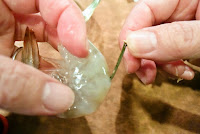Often made today with cream and sugar as a dessert, this milk pudding originally was improvised as a quasi-tofu dish about 300 years ago when the Shogun, during a visit to the pastures of Mineoka, simply mentioned his desire to eat tofu. Upon hearing the Shogun's words, a cook accompanying the Shogun made the pudding using cow's milk and kudzu found at the pastures. Traditionally, milk is the only dairy ingredient that goes into the pudding; I mixed it with additive-free tonyu soy milk to cut back on sodium in the recipe below. This pudding contains no sweetener, but its milky taste and creamy texture are quite gratifying.
1 serving (1/4 of Mineoka-dofu recipe, 1/2 of sauce recipe, shrimp & arugula):
113 calories; 5.7 g protein; 5.3 g fat; 10.8 g carbohydrate; 9.9 g net carbs; 105 mg sodium; 19 mg cholesterol; 0.9 g fiber
Whole recipe of Mineoka-dofu only:
388 calories; 14.4 g protein; 20.6 g fat; 37.8 g carbohydrate; 10.8 g net carbs; 85 mg sodium; 24 mg cholesterol; 2.4 g fiber
<Ingredients>
For Mineoka-dofu
200 g milk
100 g additive-free tonyu soy milk
25 g kuzuko arrowroot starch
1 tbsp tahini or nerigoma white sesame paste
For sauce and accompanying shrimp & leafy greens
2 shrimp in shell (34 g with heads in photo; 22 g without heads; 17 g when shelled + tails removed)
Sake (to cook shrimp, not in photo)
Handful (approx. 20 g) leafy greens (21 g arugula in photo)
2 tbsp dashi (to marinate blanched leafy greens; not in photo)
Sauce
3 tbsp dashi
1/2 tsp usukuchi pale soy sauce
1/2 tsp sake
1/2 tsp mirin
1/2 tsp wasabi powder
Slightly below 1/2 tsp water (to mix with wasabi powder; not in photo)
<Directions>
1.
Make Mineoka-dofu.
In a pot, put kuzuko and some milk, and mix well.
2.
Add tahini, remaining milk and tonyu soy milk, and mix well.
3.
Heat on medium low.
Keep stirring bottom with spatula until sesame mixture thickens, 5-10 minutes.
4.
When thickening, reduce heat to low and stir for another 5+ minutes, until it starts to look doughy.
5.
Wet inside of mold, and pour Mineoka-dofu mixture.
Drop mold from 4-5 cm (2 inches) a few times to let out any large air bubbles.
Flatten top surface with spatula.
Place plastic film directly on top, and smooth.
Chill in fridge until set (30+ minutes).
6.
For shrimp, devein with skewer without shelling.
Pour sake, and microwave without cover for approx. 60 seconds or so (1,000 watts), removing and flipping a few times for even cooking.
When 90% done (still not totally opaque), remove from microwave, cover, and let cook with heat remaining in shrimp themselves.
When cool enough to touch, shell and remove tails.
7.
Blanch leafy greens (here, baby arugula leaves are put in a small basket for easy blanching and removal).
When leaves brighten, immediately cool with cold water to stop cooking and prevent discoloration, and squeeze out excess water well.
Place in a small container, pour dashi (room temperature or cooler), and marinate.
8.
Mix wasabi powder and water.
9.
For sauce, mix all ingredients, and heat in microwave.
10.
When ready to assemble, cut and place Mineoka-dofu on individual plates or in bowls, put arugula (after gently squeezing out dashi marinade) and shrimp, place wasabi on Mineoka-dofu, and pour over sauce.
<Notes>
- The above proportion of kuzuko kudzu starch is for a softer result. If a firmer texture is desired, increase kuzuko to 30 g.
- Microwaving shrimp until done (totally opaque) will likely result in a rubbery texture.
- Shrimp can be boiled (in water and sake) instead of microwaving.
- When both head and tail ends are cut straight, shrimp would look very formal and elegant in a dish/bowl when plated. (Not done for the above.)
- The above nutrition figures for one serving is based on the assumption that 2/3 of sauce is absorbed. Figures do not include sake used to cook shrimp and dashi in which arugula is marinated.
- The recipe above can be used as a dessert when served with a sweet (sugar or fruit) sauce. If a creamier texture is desired, replace cream with tahini. Additional sweetener can be added to Mineoka-dofu itself (not to the sauce).
- Mineoka in Chiba Prefecture is known as the origin of dairy farming in Japan, and Japanese dishes using cow's milk often have "Mineoka" in their names.
- Some historical background of Mineoka: Known for its long history of pasturing, which dates back to the 8th century. In the 16th century, a local warlord established pastures to raise military horses, which later became a territory directly controlled by the Tokugawa Shogunate in the 17th century. In 1728, white cows from India were imported and brought to the Mineoka pastures, as ordered by Tokugawa Yoshimune (1684-1751), the 8th Shogun (1716-1745). Reduced or cultured cow's milk was used for medicinal purposes by the nobility, and as the cow population and production increased, dairy products became available for commoners.





















1 comment:
I am so happy I found you blog. You have some amazing recipes on here. As a European there are many things I have never eaten or seen before. I am already looking forward to trying this recipe as well as a few others I have already saved now. Thank you for the very detailed and clear discriptions!
Post a Comment